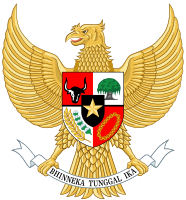
The Revised Dwikora Cabinet was the Indonesian cabinet which served under President Sukarno from February 1966 to March 1966. The cabinet was formed under an extremely tense political situation, and it was expected that this cabinet would address the concerns of the people. It was during a meeting of this cabinet that unidentified troops surrounded the Presidential Palace causing to Sukarno to escape to Bogor from where he gave Supersemar to Lieutenant General Suharto.
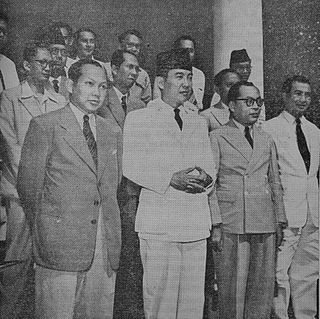
The Republic of the United States of Indonesia Cabinet was established as a result of the formation of the United States of Indonesia following the transfer of sovereignty from the Dutch colonial power. It lasted less than a year before Indonesia became a unitary state.

The Third Sjahrir Cabinet was the fourth Indonesian cabinet. It served from October 1946 to July 1947, when it fell due to disagreements related to the implementation of the Linggadjati Agreement and subsequent negotiations with the Dutch.

The First Amir Sjarifuddin Cabinet was the fifth Indonesian cabinet and was in office from 3 July to 11 November 1947.

The Second Amir Sjarifuddin Cabinet was Indonesia's sixth cabinet and was the result of a reshuffle to allow for the entry of the Masyumi Party, which gained five posts. The cabinet lasted only two months and eleven days, from 11 November 1947 to 29 January 1948, after Masyumi withdrew its ministers in protest at the Renville Agreement the government signed with the Dutch.

The First Hatta Cabinet was Indonesia's seventh cabinet. It was formed by Vice President Mohammad Hatta, who was instructed to do so by President Sukarno on 23 January 1948, the same day the previous cabinet was declared dissolved. Following the second Dutch military aggression, when the republican capital of Yogyakarta was seized and most of the cabinet arrested, much of the cabinet was captured and sent into exile, although it was not formally disbanded. After the political leadership returned effective 13 July 1949 the cabinet continued its mandate until it was reshuffled on 4 August.

Sjafruddin Prawiranegara's Emergency Cabinet was the government of the Emergency Government of the Republic of Indonesia (PDRI), effectively Indonesia's government in exile, established in Bukittinggi, West Sumatra following the second Dutch military aggression when the republican capital of Yogyakarta was seized and most of the cabinet allowed itself to be captured in the hope of attracting sympathy from the outside world.

The Susanto Cabinet was the first cabinet of the Republic of Indonesia while it was one of 16 states in the United States of Indonesia. It served from 20 December 1949 until 21 January 1950, when a permanent cabinet under the leadership of Prime Minister Abdul Halim was appointed.

The Halim Cabinet was the second and final cabinet of the Republic of Indonesia while it was one of 16 states in the United States of Indonesia. It served from 21 January until 15 August 1950, when the United States of Indonesia was dissolved and Indonesia once again became a unitary state.

The Natsir Cabinet was the first cabinet formed after the dissolution of the United Republic of Indonesia and returned to the Unitary State of the Republic of Indonesia. This cabinet was in charge from 6 September 1950 until 20 March 1951.
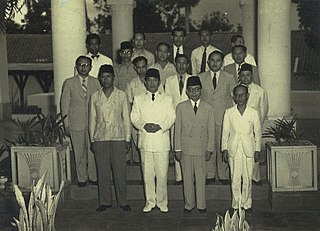
The Soekiman Cabinet, also known as the Sukiman-Suwirjo Cabinet, was an Indonesian cabinet that served from 27 April 1951 until it fell on 23 February 1952 following revelations that it had signed a mutual security agreement with the United States, and was dissolved on 3 April 1952.

The Wilopo Cabinet, also known as the Wilopo-Prawoto Cabinet, was an Indonesian cabinet that served from 3 April 1952 until 30 July 1953.

The Burhanuddin Harahap Cabinet was an Indonesian cabinet, named after the prime minister, that served from 12 August 1955 until 24 March 1956.

The Second Ali Sastroamidjojo Cabinet, also known as the Ali-Roem-Idham Cabinet was an Indonesian cabinet that served from 24 March 1956 until 9 April 1957.
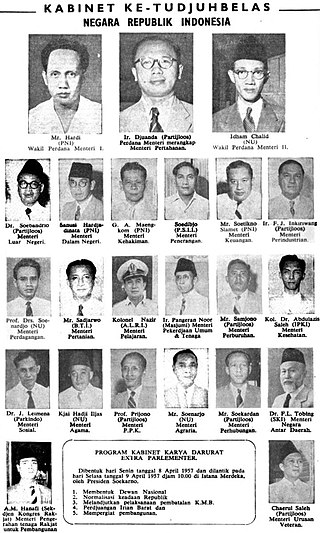
The Djuanda Cabinet, also known as the Working Cabinet, was an Indonesian cabinet that served from 9 April 1957 until 10 July 1959, when it was dissolved by a decree from President Sukarno.

The Second Working Cabinet was an Indonesian cabinet that served from 18 February 1960 until 6 March 1962, when President Sukarno reshuffled it.

The Third Working Cabinet was an Indonesian cabinet that resulted from a 6 March 1962 reshuffle of the previous cabinet by President Sukarno. It consisted of a first minister, two deputy first ministers, eight coordinating ministers, 36 ministers, as well as 13 members who headed various government bodies. It was dissolved on 13 November 1963.

The Fourth Working Cabinet was an Indonesian cabinet that resulted from regrouping of the previous cabinet by President Sukarno. It consisted of three deputy prime ministers, eight coordinating ministers, 33 ministers, six ministers of state, as well as 11 cabinet members who headed various government bodies. It was dissolved on 27 August 1964.
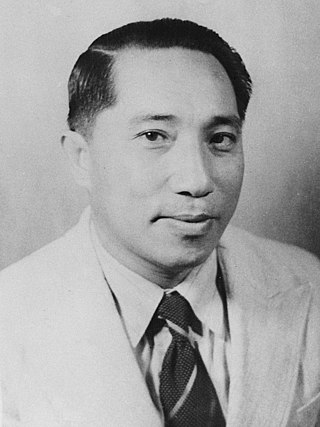
Herling Laoh was an Indonesian bureaucrat and engineer. A member of the Indonesian National Party (PNI), Laoh served as minister of public works (1947–1950) and minister of transportation (1949–1950). Born to a goldsmith and his wife in present-day North Sulawesi, he studied civil engineering at the Technische Hoogeschool te Bandoeng (THB). After graduating in 1928, he worked as an engineer in various construction projects. Following the Proclamation of Indonesian Independence in 1945, he joined the PNI and served as a minister in several cabinets. He was later involved in PRRI/Permesta rebellion, becoming a state minister in the rebel government.

The First Working Cabinet was an Indonesian cabinet that served from 10 July 1959 until 18 February 1960, when President Sukarno reshuffled it.
